Interpretation of the Breastplate
The breastplate center depicts a barbarian man in traditional Parthian dress, who some have identified as King Phraates IV1. He is giving a military standard topped with an eagle and decorated with coronae and phalerae to a man with a wolf4. Historically, Tiberius would have retrieved the standards during his expedition in the east in 20 B.C. Regardless, the Roman in military garb accepting the standards in the middle of the cuirass has been interpreted to represent any one of Tiberius, Romulus , Augustus, Aeneas, Mars, or the personified Roman army1. Due to this subject matter, the cuirass has lead many, including Kleiner, Reeder, and others to believe the statue's construction commemorates Augustus' diplomatic victory over Parthia .
Others argue this figure must be Tiberius, primarily because he is the one who commissioned the statue in honor of Augustus, but also in order for him to imply his right to succession as the hero of the Parthian victory. Furthermore, he is championed by Romulus portrayed as a wolf to Tiberius' side6.
Surrounding the central images, divinities and personifications decorate the rest of the cuirass in intricate detail. Some historians, including Morford and Kleiner suggest the two captive women to the right and left sides of the central images represent the captive provinces of Gaul and Spain/Hispaniola or possibly the territories in Germany .
Apart from these figures in the mid-ground, the rest of the breastplate is a cosmic setting populated by various gods. At the top of the cuirass, a crowned figure spreading a cape is thought to represent Caelus, the sky god, spreading the heavens over the scene4. Alternative interpretations indicate the figure at the top is either Saturn, distinguished by his crown and mantel, or Jupiter Optimus Maximus, distinguished by the veil. The inclusion of Saturn residing above the rest would signify the return of Saturn as ruler of Latium, as was the case during the first Golden Age, therefore crediting Augustus with bringing a new aurea seculae5. Vergil may even hint at this relationship in book six of the Aeneid when describing the future Augustus to Aeneas.
Paired with Caelus, is Tellus or Terra Mater, Mother Earth, at the bottom of the breastplate holding two babies and a cornucopia9. Since Caelus and Tellus are generally paired in Roman art, Reeder suggests the lower figure is instead Cybele, Mother of the Gods, making her paring with Saturn, King of the Gods, likely. Just below the topmost figure, another divus drives a chariot. Some interpret this to be Sol, god of the sun, including Morford and Klynne. Others say Apollo drives the chariot4. Next to the chariot, two other divinities, one thought to be Aurora , the dawn, is holding an urn, and the other, interpreted to be Luna, the moon, is holding a torch4. Also on the breastplate, just below the central image, is Diana riding a stag and Apollo upon a winged griffin6.
The statue was meant for display against a wall, as indicated by a metal rod down the back of the statue7. Despite this and the roughness of the rest of the back, the cuirass is still decorated on the backside with a trophy and wings1.
